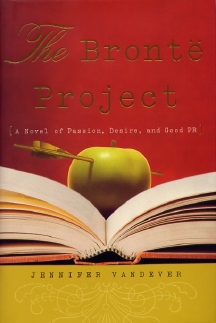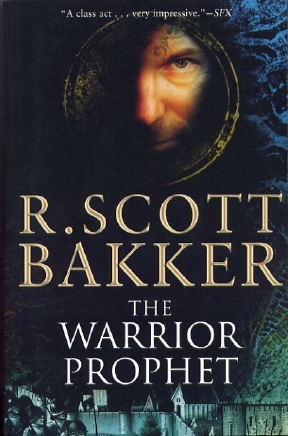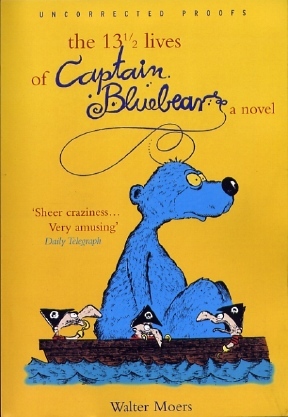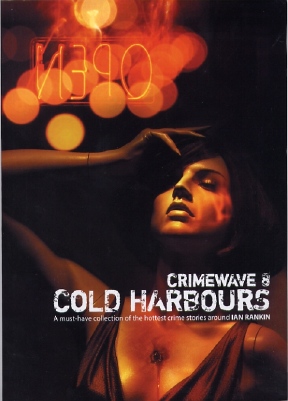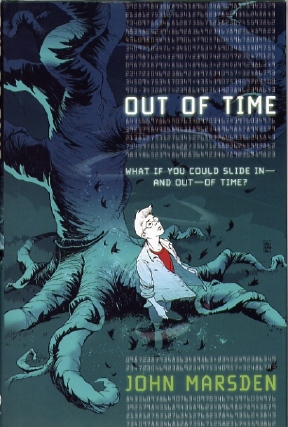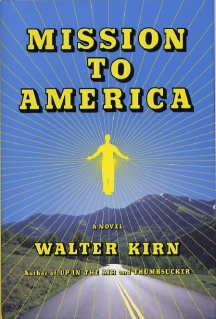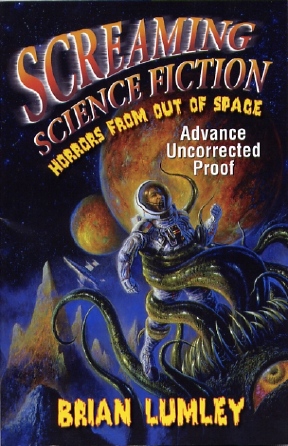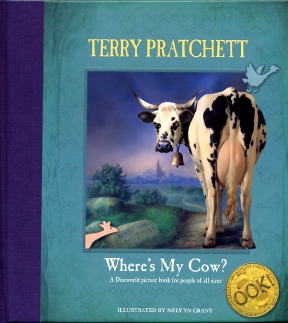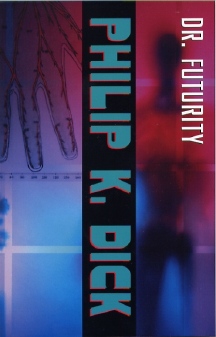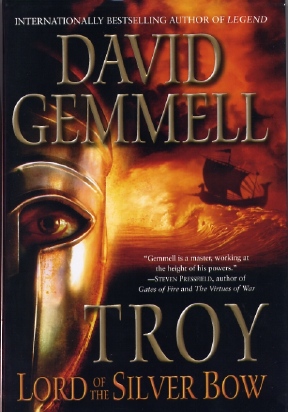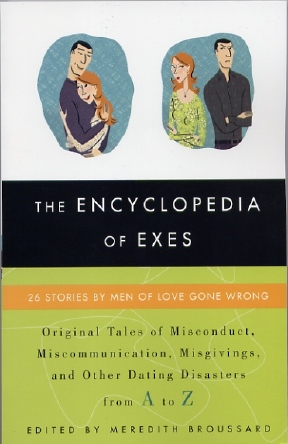|
|
|
This Just In...News from the Agony Column
|
10-07-05: Jennifer Vandever Embarks Upon 'The Brontë Project' |
|||
PR
Squared
So I spoke the word, and did not disparage. I actually appreciated it. In retrospect, I should have known what would ensue. First a column on Speculative Romance. I guess that was all that I needed to do; after that my fate was sealed. I was on the "chick lit" list. Now, look, I like a good book, and a good book is a good book, no matter what the genre. But some of the books I get...well, theyre good for someone, I'm sure, just not me. However, I have to say that conditioning lasts a long time, so my love of Jasper Fforde's 'the Eyre Affair' really pre-disposed me to be interested in 'The Brontë Project' by Jennifer Vandever (Shaye Areheart Books / Dcrown Publishers / Random House; October 11, 2005; $21.00). So it's all coincidence, the fact that the title reminds one of Fforde's novel, while the name is not so far from that of genre giant Jeff VanderMeer. You know, it's a bad idea to ignore coincidence, as Loren Coleman, author of 'The Copycat Effect' would suggest. So I didn't, and the fact of the matter is that good writing conquers all. When Vandever tells readers in the second paragraph that "Even in the most generous accounting, Fate has a lot to answer for," well, it sort of answers the question. Vandever can put together a pretty damn clever sentence, and that's a good clue that she can put together a clever novel. The idea here is that Sara Frost is a Brontë scholar looking for love letters that she's not finding. Instead she finds herself upstaged by a Princess Di "scholar". Then things get worse, then better. In between, what you'll find is scrappy not sappy writing, though you'll have to be able to bear the presence of the Princess in order to enjoy it. That's a pretty Herculean task for some of us, and I would be one of those covered. Still, it looks like Vandever's tale of PR wars and tale spinning has a damn good chance of being entertaining. And something you might buy the other half to simultaneously demonstrate good taste and good intentions. If I must circle the drain, I'm going to say something slightly more intelligible than "glug glub." I'm going to say that you might take a peek at this tart novel. Part satire, part romance, it's pretty intriguing to wonder where, exactly, the heart of this novel lies. Or if it even tells some truths. |
|
10-06-05 Update: SF on NPR |
|||
Living
With Lightning
I dont have a specific airtime yet, but it should air a few times over the course of the show, and my guess is that it will run in the final twenty minutes before the top of the hour. It's a two hour show, and we're not certain what hour it will be in. If you miss it, or live outside the range of US NPR -- and I know a few of my UK readers do -- you'll be able to get it from the npr.org website. They usually post them shortly after the show is broadcast (I haunt the site looking for Sunday's essays by Daniel Schorr). Should you be inclined, you can email the audio story to friends using the "Email This Story" button. Please do so; if enough people express an interest in this subject, you might just see increased coverage of speculative fiction, science fiction, weird fiction, horror, mystery, graphic novels and more on NPR. For me, this is a big deal. I've been working at NPR affiliate KUSP doing interviews, most of which you've heard here, for what seems like many years but proves to be a mere three. I guess it seems so long to me because I've been immersed in all the wonderful details -- reading the books, planning the interviews, recording them, traveling to KUSP and KQED and even doing location recordings. But it's only three years. Well. Some time ago, during my travels through the world of NPR, I met a wonderful editor who expressed an interest in the kind of fiction we cover here in The Agony Column. I kept the contact and this summer, when I was listening to NPR, I heard the batches of book reviews and wanted to do a set myself. I was positively bubbling with ideas, and eventually pitched an idea my editor liked. It was sort of like plopping a raw human heart down on the table saying, "I will build a living soul from these spare parts!" Easier said than done. Of course, I knew as much about putting together a story for NPR as I did about sewing together human body parts and re-animating them into a living creature. Actually, I knew more about the latter, as I'd seen it done in movies and really, you know, it looks pretty easy so long as you live in a place where there's a lot of lightning. The process itself proved to be challenging but really, really fun, because I was working with a fantastic and wise editor who knew not only how to shape a great piece of audio news for NPR, but also how to get the best performances, both written and spoken, out of me. It was a fascinating learning experience; much of the script is the result of her suggestions, edits and re-writes. But I listened and learned. If the reaction to this story is positive, if readers like it enough to email it around, then I have reason to hope that there will be more stories in the future, which will benefit greatly from this experience. Of course, the many guests and authors I talked to before, during and after Worldcon are to be thanked. Alas, I could not include them all, but that proved to be a very valuable lesson. The three writers who ended up in the piece – Terry Pratchett, Susanna Clarke and Kazuo Ishiguro – all provided lots of stellar material which also fell to the cutting room floor. There's only so much you can do in a seven-minute piece of audio. But thanks to my editors and producers and guests, I think it's a pretty hot seven minutes. It's SF on NPR, and it takes the genre seriously -- but not too seriously. Email me if you have any questions about this, and I'll answer them if I can. But more importantly -- listen, enjoy, and email the story from the npr.org website on Sunday and in the days that follow. Not surprisingly, there are lots of stories to tell about the people who tell us stories. They have lots to say (as do I) and I hope to give us a big, respectable and entertaining forum in which to say it. |
|
10-05-05: Walter Kirn on a 'Mission To America'; Brian Lumley is 'Screaming Science Fiction' |
|||
Road
Trip Religion
Fortunately for me, I'm perfectly unaware of Kirn's other work, and so I come to 'Mission to America' with perhaps a fresher set of eyes. And those eyes see something worth picking up, at least if youre interested in a satiric look at American mores and morals. As the novel begins, life is sweet for Mason LaVerle. He's a member of a very obscure matriarchal religious sect, the Aboriginal Fulfilled Apostles. Based in Montana, the Apostles' main tenet is that They Approve; "We approved of the Prince of Flocks, whom others called Christ...but also a host of other divinities, majestic and humble, familiar and obscure, from tricky Old Coyote, the Hopi spirit to dainty Lady Vegetalis, a garden sylph of cloudy origins." Okey-dokey. The problem for the Apostles is that they're literally running out of members. They need some new blood – specifically, women – to ensure that the sect doesn't just wither away, so to speak. So Mason is sent out on the titular mission by the Seeress. He's to be accompanied by Elias Stark, an Elder in the sect. They pack up the van and hit the road to bring home some brides. Kirn tells his story via Mason's first-person perspective. Whats interesting here is that the Apostles may be unknown and a bit weird, but they're not completely isolated. They know that they're heading off into a Land of Sin and Idiocy. Their plan: get some women. Not their plan: meet Internet Porn goddesses. Well, it's a religious book, no? This plan shouldnt be too hard, eh? Well, it's at least 271 pages hard. Kirn has a nice, light touch to his prose, and the ideal "fish out of water" perception. It comes from his background as a lapsed Mormon. "My years as a Mormon taught me," he says, "that in America, depending on your beliefs, you can shop in the same malls, watch the same movies, listen to the same music, and yet reside in a totally different country as a kind of stranger in a strange land." Kirn's religion here is a matriarchy, based a bit on sects like Mary Baker Eddy's Christian Scientists and on those sects who control the diets of their members. One of those things that seem fairly loony until you see how common the tenets are. Anyone know about the Breatharians? By pairing up Mason not with another young man, but instead, an Elder, Kirns keeps an entire genre of cheesy road novels at bay. And his rather gentle, low-key approach allows him to take on some very serious issues without turning into a fire-breathing demagogue. This whole acceptance vibe allows him to include as opposed to exclude, and perhaps lets Kirn get some darts into the heart of a very contentious issue; religion in America. And that's exactly what he wants. "In America, religion–religion of all kinds, not just the church-and-synagogue mainstream stuff but the zillions of nontraditional faiths (many of which we invented, such as Mormonism) from Scientology to New Age channeling groups to the folks who hold meetings about The Course in Miracles or claim to get revelations from UFO's–is nothing less than the story of the country." I can't say that I agree totally with this, but it's not far from the truth. The Scientologists were out offering "Stress Tests" in downtown Santa Cruz this weekend, and it looked like they had a few takers. Of course, their pleas to "see if you have too much stress in your life" were also met by those who responded that their beliefs kept stress at bay. But no matter what you believe, belief itself is always fodder for great writing, whether it is religion or about religion. Most religions are born in writing; something to keep in mind whenever you read. |
|||
Scary
in Some Sense
You have to give Bob Eggleton credit for providing the perfect proportions of garish cheese to this painting. If it was the 1970's, I'd pay to have it put on the side of my van, you know, the one with the "If this van's rockin', don't come knockin'" bumper sticker? The days of airbrushed surfer vans may be gone, but happily, 'Screaming Science Fiction' seems to enjoy an Endless Summer. The evidence of this truth is to be found on the copyright page, where you can see that the earliest story in this collection, 'No Way Home', dates from 1975. Some of you were waiting to be born, others to graduate from high school -- or college. The rest of the selections cover the eighties, the nineties and the oughties. They include the original-to-this-collection novelette 'Feasability Study'. And once you get past the copyright page, you'll enjoy not only Brian Lumley's finest horror sci-fi, but more illustrations by Eggleton. Lots of them and lots of monsters to boot. Oh the joy. Lumley's been on the forefront of grotty, dripping, slime-covered sci-fi for a long time. In this he follows the footsteps of Lovecraft, but Lumley's got his own special take on the matter. "I have been asked on several occasions why I cross genres. In fact on one occasion, I was asked why I 'stagger' between them." The answer is clear if you've ever read Lumley; he may have said, "stagger", and that's not untrue, but there's a good deal of swagger as well. Some writers operate with a scalpel, but Lumley enters the theatre with a machete. One thing about Lumley's short fiction is that a great deal of it was published in venues not easily found on these shores, including Paul Ganley's exquisite 'Weirdbook', from which we get 'The Man Who Saw No Spiders'. Oh, doesn't he just wish that were the case! The only title familiar to me is one of Lumley's best recent works, 'Big "C"', from 'Lovecraft's Legacy'. The upshot of this is that here's a collection of stories you've probably not seen, illustrated by a master, written by a master, and offering well, "HORRORS FROM OUT OF SPACE." 'Screaming Science Fiction' is the kind of work that just makes me smile. You open up this book and know that there is something both quite well-written and sleazily entertaining within. Guaranteed monsters and guaranteed pictures of those guaranteed monsters. Life is good. Time to hop in the van, head down to the beach. Of course, the van has windows, and all sorts of seats for kids. If it's rockin', I'm likely to be telling someone to SIT DOWN. But both of us are likely to enjoy a good monster story. |
|
10-04-05: Reset: 'Where's My (cash) Cow?' by Terry Pratchett; Dr. Futurity by Philip K. Dick |
|||
This
Book Goes "Moo!"
In fact, have 'Where's My Cow?' instead. If you've read Pratchett's latest novel, 'Thud!', and it is well worth reading, then you know that 'Wheres My Cow?' is the beginning reader book that Sam Vimes rushes home to read young Sam Vimes, every day at 6:00 PM sharp, because, and I'm quoting here, "some thing are important". In Pratchett books, many things are important; great characters, excellent plots, incisive commentary on The World We Live In, and, of course, generous good humor. And in 'Thud!', as it happens, 'Where's My Cow?' is very important, not just to Vimes, but to the novel itself. I can't imagine anyone who reads 'Thud!' not wanting to read 'Where's My Cow?', as silly as it seems. Pratchett invests the book-within-a-book with such charm that I had to make two visits to the bookstore to buy the damn thing. But he does a lot more than just charm with this little book. First off, he got a great illustrator, Melvyn Grant, to realize his peculiar vision. Then, he went and wrote something a lot more interesting than your average board book, something that, while it might require a Discworld junkie to explain all the nuances, certainly does its audience the favor of giving them some credit for being able to understand a sophisticated story. This is the kind of book where a character in the book (Sam Vimes) takes the book in question down from the shelf to read to young Sam. So reader and readee, so to speak, get wrapped up in the book they are reading. Grant's illustrations do a very nice job of combining a realistic and a surrealistic style. Pratchett adapts well to the requirements of a child's book. Even if you dont have a kid to read the book to, you'll enjoy it. Yes, it's true that those who have some familiarity with the mean streets of Discworld will get more out of this book, but Discworld is filled with the sort of archetypes that pretty much anyone can glom on to. This isn't rocket science or even series science, or even science fiction. It's a goofy kids book straight out of a book that is likely a best-seller. I can imagine the people at HarperCollins, rubbing their hands with glee as the read the manuscript of 'Thud!', thinking how they could make this book and double their sales. When you hear about this book, you might want to think that this is just a cash cow, easy money. It's anything but. 'Where's My Cow?" is easy money, all right -- easily spent, that is. Try and stop yourself. Of course, if you do, you might not ever find out where the cow is. |
|||
Completing
the SF Collection
'Dr. Futurity' is typical Dick, from a bit before what most people think of as his best work. A talented doctor is shot into the future where it is illegal to save lives. What's he to do but set about undoing history. At 169 pages, Dick packs more into one of his little novels than most writers these days get into a trilogy, and he serves it up with extra cheese. I enjoyed 'Dr. Futurity' back in the day, but if you've not read the essentials, then I'd suggest 'Ubik', 'Time Out of Joint', and 'The Three Stigmata of Palmer Eldritch'. I also might suggest that if youre of a compulsive, collecting mentality, then you could spend some say, $400.00 and have a couple shelves full of every Philip K. Dick SF novel in a standard edition. And you could spend another $400.00 for your time capsule investment copies, and it wouldnt be a bad idea. For all that the publishers want you to think that Dick is of a kind with Italo Calvino and Jorge Luis Borges, that's really stretching the point. Dick is a science fiction writer, who used the cheesiest science fiction concepts to treat some rather advanced philosophical ideas. Time travel, space travel, extra-dimensional travel, he was the genre's first travel agent. But for all the external, in-yer-face Sfness of his work, he did have some rather sophisticated literary ideas. He was really a bundle of contradictions, the ultra-commercial and the expedient wrapped together with high-concept, high-art. I think it's the combination as much as the high-art content that makes him so compelling to us today. There's also a very nice and very weird effect of his dating so many of his futures in what proves to be our past and present. Heck if science had progressed as fast as Dick suggests in his novels, we'd have blowed this planet up half-a-dozen times by now. But as long as the planet remains un-blowed-up, readers can get their fill of one of the last century's most interesting writers. A whole shelf-full. Reading Dick is addictive, and now, thanks to Vintage Books, you can satisfy that addiction. And without a three mile walk through the snow sans shoes. |
|
10-03-05: David Gemmel's 'Troy:Lord of the Silver Bow'; Meredith Broussard's 'The Encyclopedia of Exes' |
|||
Hiding Fantasy Inside History
So what you have here is Virgil's 'The Aenead' remade as a modern action fantasy flick, er novel. Except for the fact that the plot is totally different. Well, who wants to argue details, eh? Gemmel's novel begins with Troy still strong and Aeneas a feared warrior with a bunch of aliases. You know, like "Mack the Knife" or "Nicky Knuckles"? Aeneas gets dubbed 'Lord of the Golden Bow', which is to my mind, a bit of a mouthful. But he's also got an AKA of Helikaon. You know, one of those out-of-the-blue nicknames you get sometimes. Unsurprisingly, he also has a nemesis, also with an A-name, in this case Argurios. The nemesis does not get an alias. Argurios is one of the Mykene warriors. Got that, Mykene? 'Cause I'm going to come back to that. But at any rate, Argurios is sent out to scout the defenses of Troy, Mykene's bitter enemy. And of course, there is a woman in the mix. You know what, and I hope you're sitting down, she's a strong willed lass named Andromache, whose arranged marriage to Hektor is pissing her right off. So what do you think that the odds are that these three are going to do more than meet and greet? Pretty good, huh. Let the battle scenes begin. Now, I have no doubt that Gemmel can write one hell of a page-turning battle scene. I read one, and it was you know, white-knuckle stuff. Weapons and limbs flying every which way. Plundering, fleeing women and children and such. And I rather like the idea of doing these historical based fantasy novels. But being the pedant and whinger I am, I do have to ask one little question. What's the deal with the names? It seems that every writer wants to come up with their own spin on how to spell the names of various ancient Greek warriors, gods, characters, places, nations–whatever. I know that everybody wants to be original. But all the variations on spelling out the names, well, it's starting to bug me. Gemmel's big innovation here is "Mykene" for Mycenean civilization. (I think; I couldnt find out anything about the Mykene Civilization.) The thing is, this substituting a "k" for the normal-to-me "c", well, it's not new. Maybe I'm being petty. Probably I'm being petty. But I'd like to see all of us go back to the Bullfinch's standardized spelling (or misspelling, I'm sure I'll be reminded by one more scholarly than I) of all these Greek names. Yes, not realistic, but then, I deal in unrealistic fiction for the most part, dont I? The way I figure it, I'm allowed. But not matter how he spells the names, Gemmel surely executes his novel rather elegantly. He re-tools, as Hollowood is fond of saying, the Greek myth into a modern-style historical best-seller. Hot sex and cool battles. Big ships and big, uh other things. Best left to the imagination here, and probably not left to the imagination there. The big question for 'Troy: etc etc' is not the size of anything, but rather the ULTIMATE DILEMMA. Historical / general fiction or fantasy -- where to shelve it? The idea of writing these books, beyond you know, art, is to me to escape from the Fantasy Ghetto. Not a single stinkin' unicorn here, and no dragons either. No wizards. So you sort of want to put this with the other so-called "normal" books, where it has a chance of attaining the bestsellerdom it surely aspires to. But if you do that a large portion of the readers that will help make this a bestseller are going to be poking about the fantasy section, wondering, "Where's that damn Gemmel book Kleffel was on about? It sounded pretty good to me!" And we know it's verboten to shelve a single book in two places. It messes up the inventory system. This literally just in – at Bookshop Santa Cruz, this book was piled in the General Fiction new releases. I was shocked, really. Gemmel has done busted out. Will he ever return? Should it show up elsewhere in your bookstore, email me. Maybe the book can catch a ride in the boat on the cover, which is surely departing from Fantasyland and headed towards a less magic part of the magic kingdom. |
|||
A to Z of Bad Relationships
I mean, look. The authors are all guys, and more than guys, there's a mattering of manly men among them, not just a pack of namby-pamby writers. Neal Pollack. Steve Almond. Etc. (Not an author name.) Then you get this girly girl editing the book. Kind of hot, you might guess from the postage-stamp author photo on the back. And with a past, no less, a sort of literary ex, in that she edited the probably-a-companion-volume-don't-you-think, 'The Dictionary of Failed Relationships'. "Hi, I'm the editor of 'The Dictionary of Failed Relationships'." A great opening line dont you think? Certainly an expectation-setter. And the ultra-girly-girl cover. Not that I dislike it or anything. But if you're going to publish a book of stories by men about bad relationships, you'd be better off illustrating it with say, a photo of a crushed beer can and a crumpled condom wrapper. So maybe the intended audience is women. Or both sexes. But I have to say that as much as I was ready to drop this like an ex-girlfriend who calls too much (not that there are too many of those in my past, mind you) I did take a long enough peek at the TOC to note some pretty intriguing authors. Above noted manly men. Other more sensitive guy types as well. Jonathan Lethem, who probably wouldn't be regarded as particularly sensitive if they'd published his story 'Five' here under its original title of 'Five Fucks'. And you know, you should just know that I stared at that TOC long and hard before I twigged to the fact that there are 26 stories, and they are literally A-Z. Oh so clever. But these are short, short stories, and damn if you couldnt whip through a few of these while tapping your toes and checking out the babes / dudes in the bookstore. Could a reader possibly, ever, hope for a better way to advertise, "I'm single"? Or maybe that would be "available" if you're of lesser moral fiber. The real problem is that these stories definitely trend towards the humorous, and most folks when they laugh, well, its not a pretty sight. So if you're hoping to use this book as a sort of sign around your neck, well, here's the rare case where I'd advise not reading it in the store. And anyway, if nothing happens, and nothing is likely to happen, then you can buy it, go home, hunker down with a beer (or a glass of wine if youre of the delicate sex), read it and say, either, "Yeah, that 's me, aren't I bitchin'," or "Man, he's (she's) just like the jerk I used to date!" You know that's the interesting aspect to fiction not often mentioned. How we always see ourselves as the hero, even if realty suggests we more closely resemble the villain. And that gets me to V! ("Virginity" by Neal Pollack, if you must know.) |
